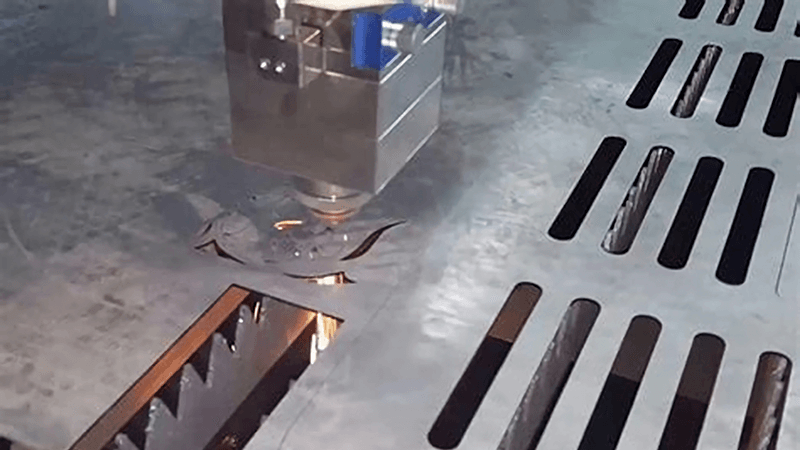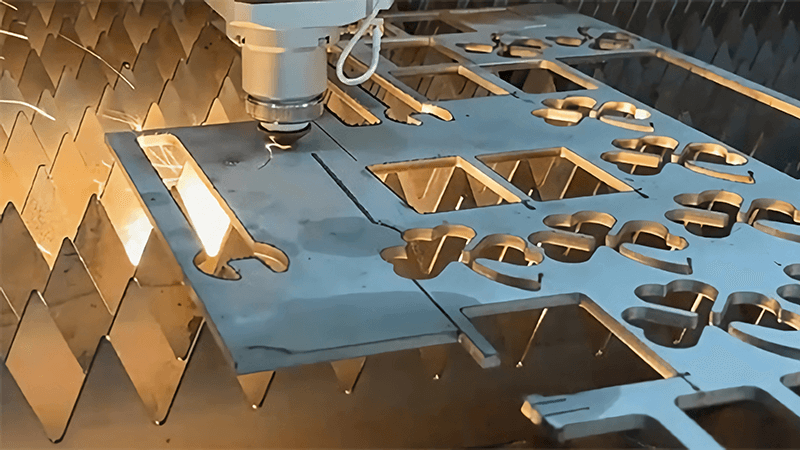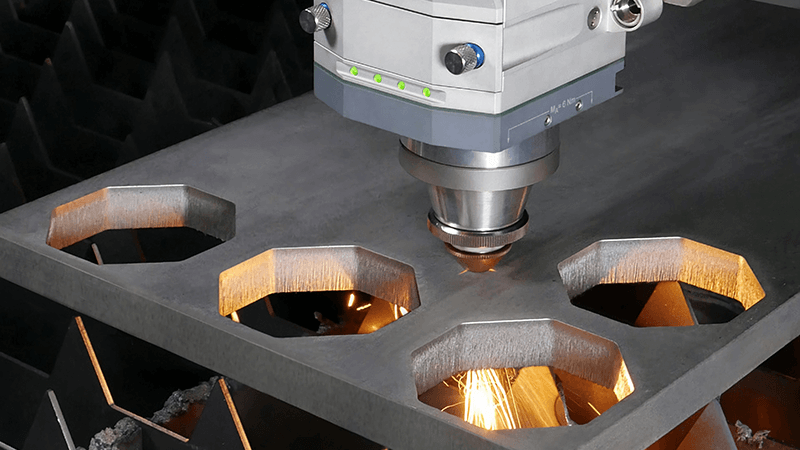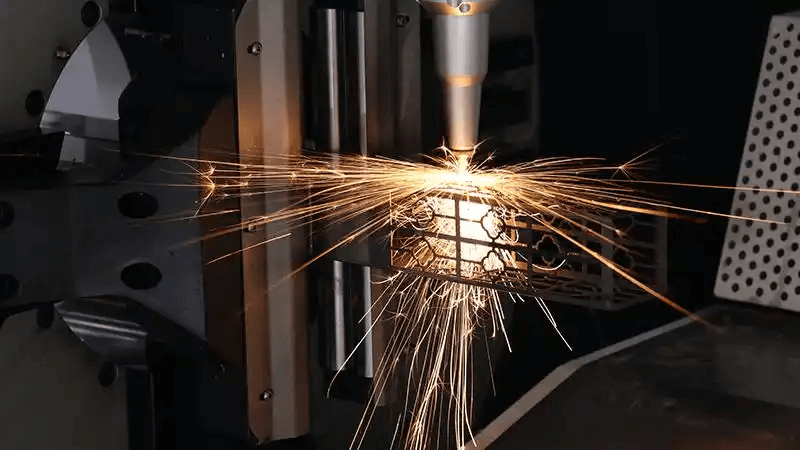Modern manufacturers demand speed, precision, and consistency. Yet, traditional metal cutting methods often fail under pressure — they create waste, slow production, and limit design freedom.
The most cutting-edge technology in the metal cutting process today is fiber laser cutting — it combines precision, speed, and efficiency unmatched by traditional methods.
With years of experience building OEM laser machines at Kirin Laser, I’ve seen firsthand how fiber laser cutting transformed industries from automotive to aerospace. Let’s explore how the process works, why it’s different, and what makes it the preferred solution for professionals around the world.

What is the process of laser cutting metal?
Metal is hard, and precision is harder. Traditional cutting tools wear down, leave rough edges, and waste both time and material. Laser cutting solves that — cleanly, efficiently, and at scale.
Laser cutting metal involves focusing a high-powered fiber laser beam onto the material, instantly melting and vaporizing it along a defined path controlled by CNC software.
How Laser Cutting Actually Works
Laser cutting is a subtractive manufacturing process1 that uses a focused beam of light. Here's how it typically flows:
Step-by-step breakdown:
| Step | Description |
|---|---|
| 1. CAD Design | Part is designed using CAD software |
| 2. G-code Generation | CAD is translated into machine code for movement and pathing |
| 3. Beam Focusing | Fiber laser beam is focused on the metal's surface using a lens |
| 4. Cutting Action | The laser melts the metal, assisted by a gas (O₂, N₂, or air) |
| 5. Motion Control | CNC guides2 the laser head in precise paths over the workpiece |
This process results in micron-level precision3, with edge quality that often requires no post-processing.
At Kirin Laser, we integrate high-accuracy servo motors and stable CNC platforms into our fiber machines — ensuring consistency even on high-speed production lines. When we upgraded one of our clients in precision tooling from waterjet to fiber laser, their cutting time dropped by 70%, and they eliminated costly finishing work.

What is the cutting action in a laser cutting operation?
Cutting through stainless steel or aluminum isn't just about heat — it's about control. Poor beam control leads to burrs, burns, and costly rework. That’s where fiber laser precision comes in.
In a fiber laser cutting machine, the cutting action occurs through concentrated energy absorption and material ejection, enabled by a fine-tuned, focused laser beam and high-pressure assist gas.
What's Behind the Actual Cut?
The laser beam is guided to the material, where energy absorption causes the metal to melt or even vaporize. This energy is so concentrated that cuts happen in milliseconds. Here's a deeper look:
Key Technical Parameters
| Element | Function |
|---|---|
| Beam Power (W)4 | Higher wattage = faster cuts and thicker materials |
| Spot Size | Determines the precision and energy density |
| Assist Gas5 | Removes molten material; O₂ increases cutting speed, N₂ improves edge quality |
| Cutting Speed6 | Dependent on power, material type, and thickness |
We recently equipped an aerospace manufacturer with our 3kW fiber system. Before, their plasma cutter left inconsistent kerfs and heat marks. After installation, scrap rates dropped by 40% and parts no longer needed secondary cleaning — just pack and ship.

What is the technology of laser cutting machine?
It’s not just a laser. It’s a fusion of optics, motion control, cooling, and automation — each component must perform flawlessly for 12+ hours a day.
Laser cutting machines use fiber laser sources, precision optics, motion control systems, and software to deliver clean, accurate cuts across metals like steel, brass, aluminum, and titanium.
Components That Matter
Let’s break down what makes a fiber laser cutting machine truly cutting-edge:
Core System Elements
| Component | Purpose |
|---|---|
| Fiber Laser Source7 | Emits the high-intensity laser beam (IPG, Raycus, MAX) |
| Beam Delivery | Delivers laser through fiber cable to the cutting head |
| CNC Motion Platform8 | Moves the laser head or work table precisely in X-Y-Z axes |
| Cooling System | Regulates temperature for laser and components |
| Controller + Software | Manages the entire operation, from file to finish |
At Kirin Laser, we customize each machine’s build — from laser wattage to control system — based on the customer's material types, thicknesses, and production volume. We also offer auto-nesting software9, saving raw material by optimizing every cut layout.
For a metal fabricator in the U.S., we recently supplied a dual-bed 6kW unit with automatic loading. Their previous setup required two operators per shift; now, one technician runs double the workload, with remote monitoring to boot.

What type of laser cutter cuts metal?
Many options exist — but not all laser types are suited for cutting metals. Picking the wrong tech leads to poor results, wasted materials, and high maintenance.
Fiber laser cutters are the ideal solution for cutting metals due to their high power density, wavelength suitability for reflective materials, and low operational cost.
Laser Types That Cut Metal
Let’s compare the popular laser types used in metalworking:
Comparison Table
| Laser Type | Suitable Metals | Advantages | Disadvantages |
|---|---|---|---|
| CO₂ | Mild steel, thin stainless | Low initial cost | Struggles with reflective metals10, high maintenance |
| Fiber | Stainless, brass, aluminum, copper, titanium | High speed, low maintenance, cuts reflective metals | Higher initial cost |
| Nd:YAG | Limited use | Pulse welding/marking | Not ideal for cutting |
From experience, I’ve used both CO₂11 and fiber systems. While CO₂ lasers work fine for engraving or non-metal jobs, they fall short on reflective metals. Fiber12 lasers excel where others fail — they slice through brass, aluminum, and even copper with ease and precision.
One of our European clients replaced their entire fleet of CO₂ cutters with 4kW Kirin fiber units. The result? 2x faster production and 50% lower maintenance costs — all with cleaner cuts and fewer consumables.

Conclusion
Laser cutting metal13 is no longer just about heat — it’s about control, speed, and smart integration. At Kirin Laser, we build machines that give our clients a competitive edge — from small workshops to aerospace giants. Fiber laser technology is the present and the future of industrial metal cutting, offering unmatched precision, lower costs, and scalability. Whether you're cutting thin sheet metal or thick stainless steel, the right machine makes all the difference.
-
Understanding subtractive manufacturing is crucial for grasping how laser cutting differs from other methods. Explore this link for a deeper insight. ↩
-
CNC guides play a key role in laser cutting accuracy. Learn more about their function and importance in this detailed article. ↩
-
Micron-level precision is vital in laser cutting. Discover its significance and applications in this informative resource. ↩
-
Understanding Beam Power is crucial for optimizing laser cutting efficiency and achieving desired results in various materials. ↩
-
Learning about Assist Gas can improve your cutting process by enhancing speed and edge quality. ↩
-
Exploring Cutting Speed can help you enhance productivity and quality in laser cutting applications. ↩
-
Understanding the Fiber Laser Source is crucial for optimizing cutting efficiency and quality in manufacturing. ↩
-
Exploring CNC Motion Platforms can reveal how they improve accuracy and speed in laser cutting processes. ↩
-
Auto-nesting software can significantly reduce material waste and improve cost efficiency in production. ↩
-
Learn about laser performance on reflective metals to choose the right technology for your specific applications. ↩
-
Understanding the limitations of CO₂ lasers can help you make informed decisions for your metal cutting needs. ↩
-
Explore the benefits of fiber lasers, including speed and efficiency, which can revolutionize your metalworking processes. ↩
-
Find the best laser cutting machine and laser cutting solutions from Kirin Laser, clicking this link to get your best product for your business. ↩





